If you want to skip directly to the other parts, then just hit
Part II - Kerala, Mysore, or
Part III - Goa, Bombay
Introduction
This is an abridged description of a roundtrip through Southern India (see map below) commencing November 1989. The intention is to give a firsthand personal experience of how I did get to and through the country. Despite the fact that I did not book anything in advance at all (except for the flight to Madras) and that I covered almost 4,000km within the country during four weeks, it was no problem getting any means of transport or accommodation on the same day. I only did some kind of pre-planning in so far that I wanted to be in Bombay at least a couple of days before my flight to Colombo.
At the time of writing all this, more than 19 years have passed. What I had seen and experienced, may not be the way today anymore, but the Indian cultures and customs do not actually change rapidly despite our global world.
What definitely has changed are names, locations and prices of accommodations and restaurants, thus they will not be mentioned (forgot them anyway).
Sometimes, I slip into a writing habit:
It's like a tic,
I can't help it.
If you won't read it,
then just leave it
and take the liberty
to skip my silly poetry.
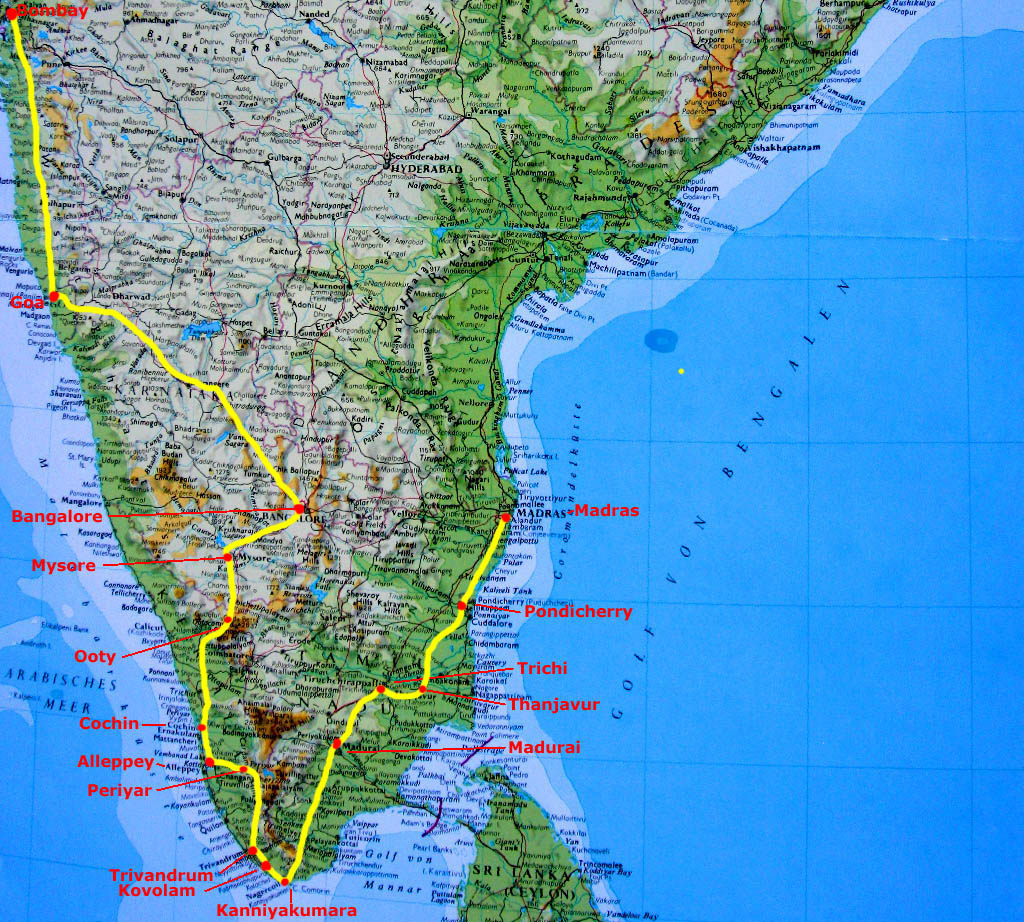
Getting from Germany to Madras
The Sri Lanka Airline flight from Frankfurt to Madras via Colombo and return from Bombay with a stopover in Colombo did cost 1,550 DM (around 775 Euro).
In order to get from Cologne to Frankfurt I had to take the train. Arrival time in Madras was in the afternoon.
Madras
At the time I was there the city was still called Madras. It has been named by the British. Now its name is Chennai. Many Indians speak English (more than in the USA) but they don't seem to like the names given by the English. Same with Bombay becoming Mumbay and Calcutta becoming Kolcata.
On the plane from Colombo I met an Arab from the Emirates looking for company and we settled down in the same hotel. He also was looking for a heart specialist to get a check-up and maybe an operation. I didn't understand why he couldn't get that treatment at home, where medical state of the art actually was supposedly high and health service was all free anyway.
We first strolled around to get an impression of life in an Indian city and to look for a restaurant. My first Indian experience was the Indian cuisine: all flame. The Massala was so hot and spicy that I could only eat half of it (a good diet). Back in the hotel my second experience was a wedding, Indian style.
Remark: The photos on the right side may not be correctly adjusted if you use Mozilla Firefox or Chrome. I propose to use the Explorer of Microsoft instead.
Click the small picture to get it enlarged
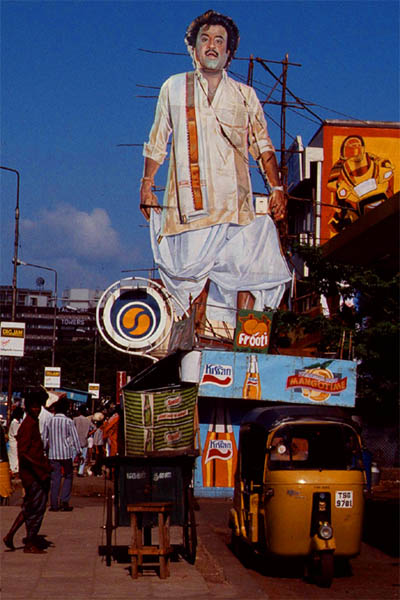
| Madras reception
|
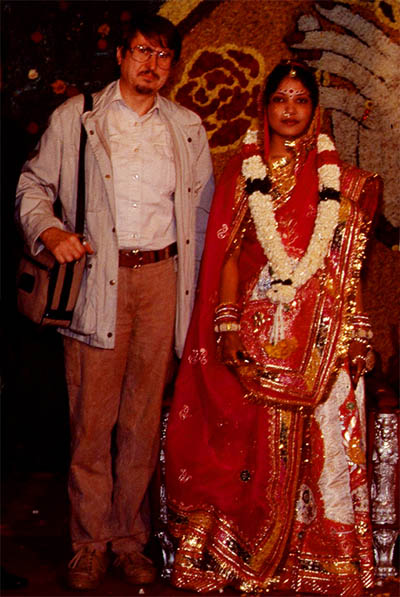
| Wedding reception
|
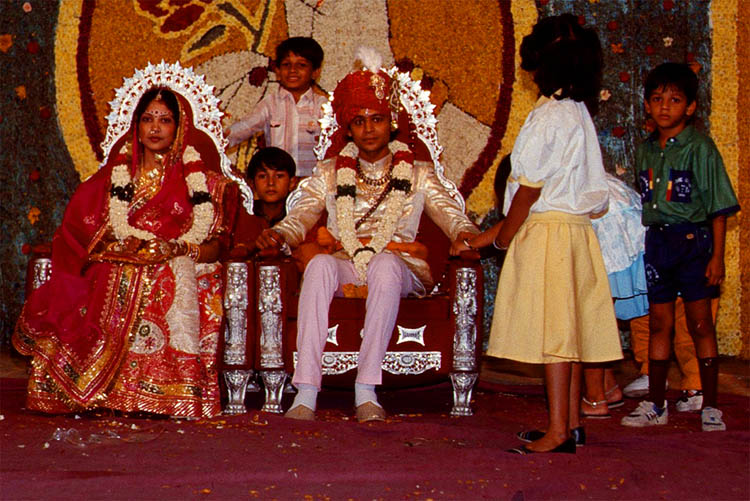
| Bride and groom very young and nice they look
|
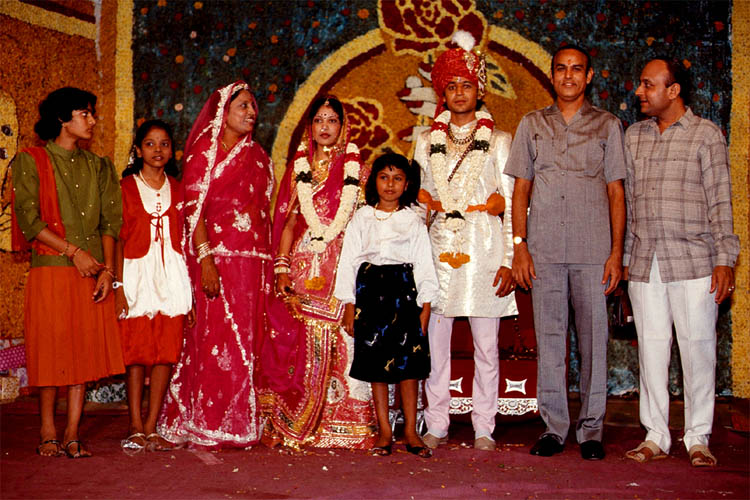
| out from the "Thousand and One Nights" book
|
My third Indian experience was better than expected. The city of Madras was comparatively clean and organized. Not what you used to see in the media about Indian cities. And this impression prevailed during my whole trip through Southern India. Later I read that India has a South to North decline and not the other way around as in many other countries or regions.

| This tusk gateway opens like a welcome to India
|
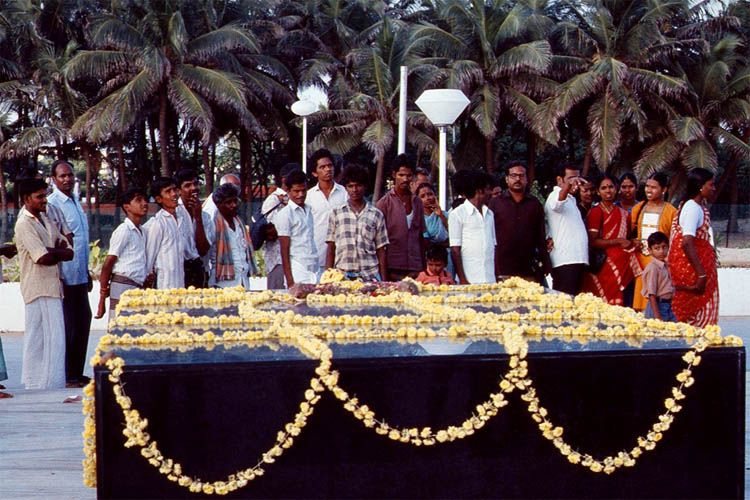
| Will I also understand all the mysteries of India?
|
Ok, I didn't go around much to also look for a possible bad side of Madras. But the good side definitely was the mile long golden sandy and lively beach, especially in the evening.
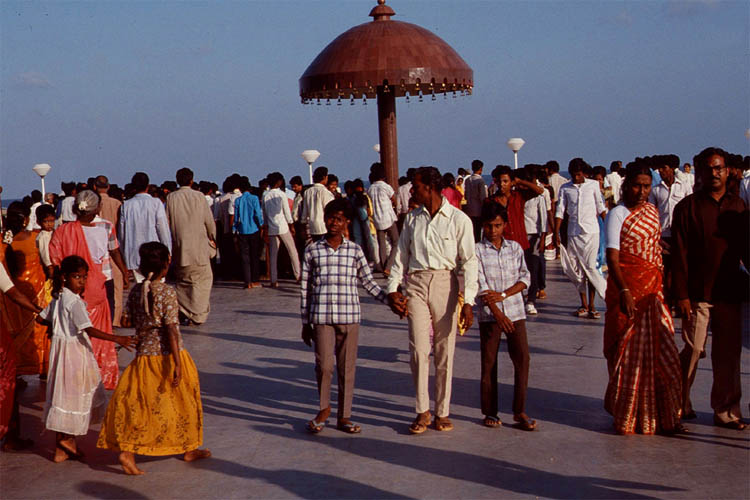
| Is this a special Indian holiday today?
|
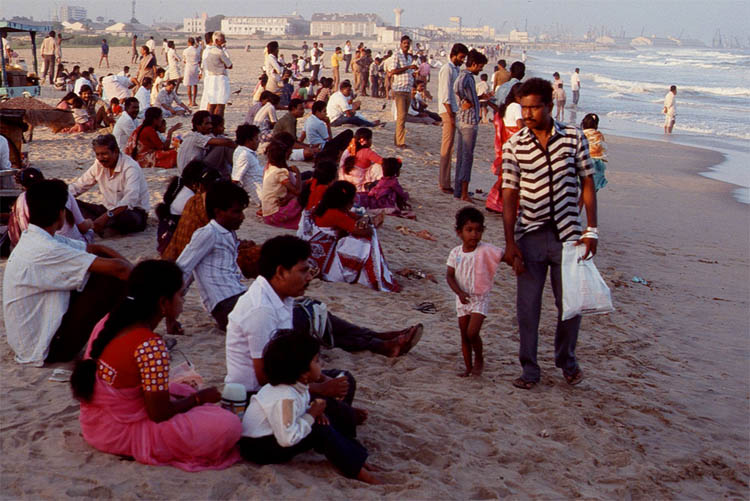
| Or are they going to the beach every day?
|
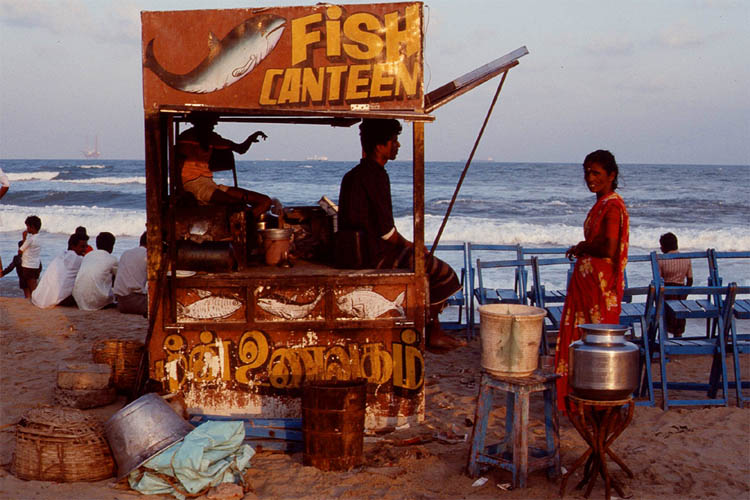
| Fish and chips seemed to be sold out
|
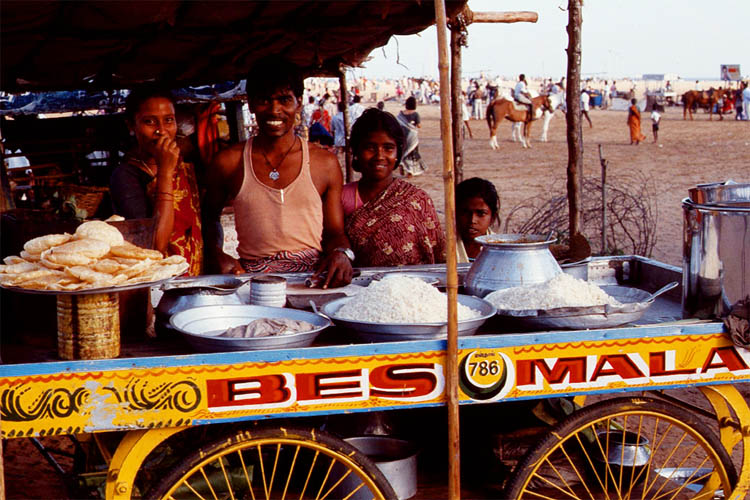
| But here you can buy rice with chili sauce
|

| It's also a small market place
|
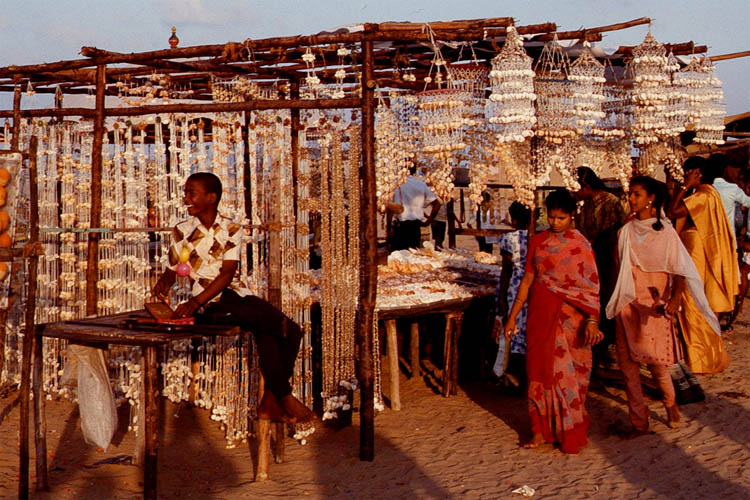
| selling souvenirs made of shells
|
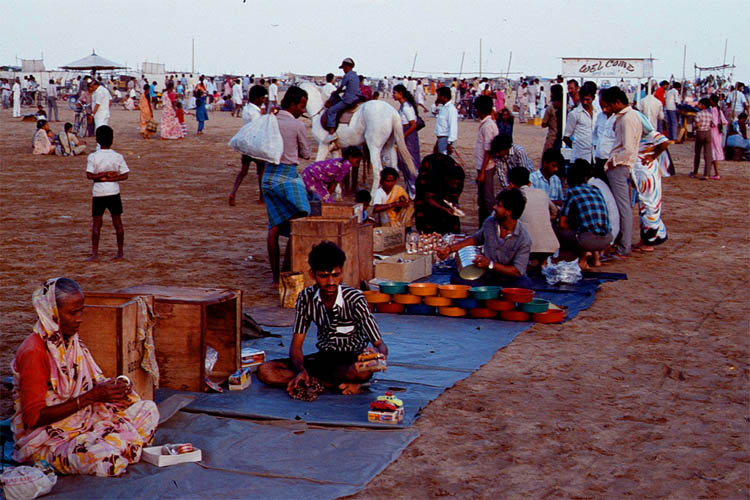
| It's a bazaar and a fairy ground
|
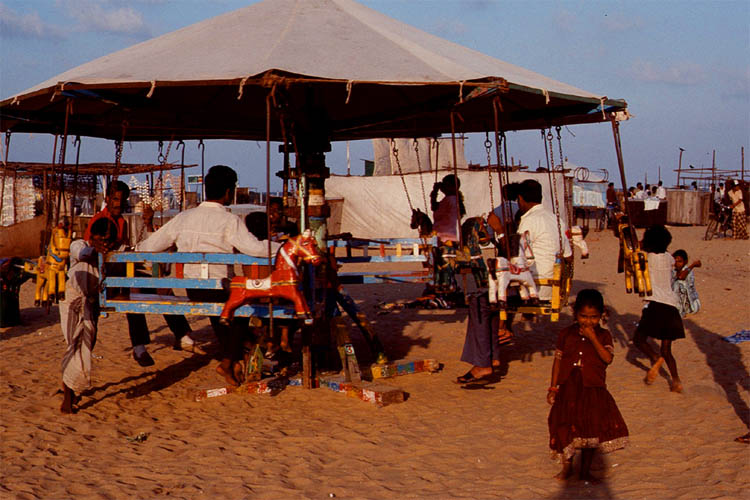
| with a merry-go-round
|

| Going around and around is fun
|
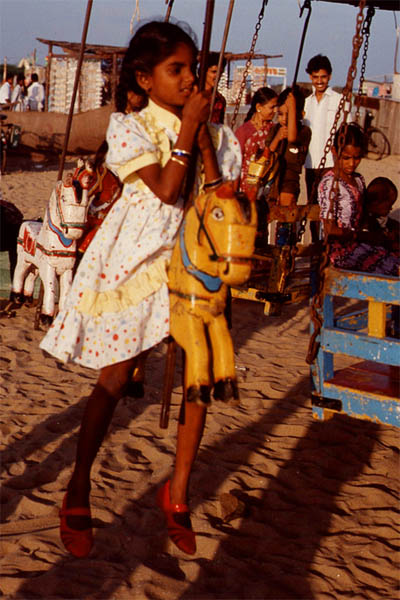
| Happy girls in the evening sun
|
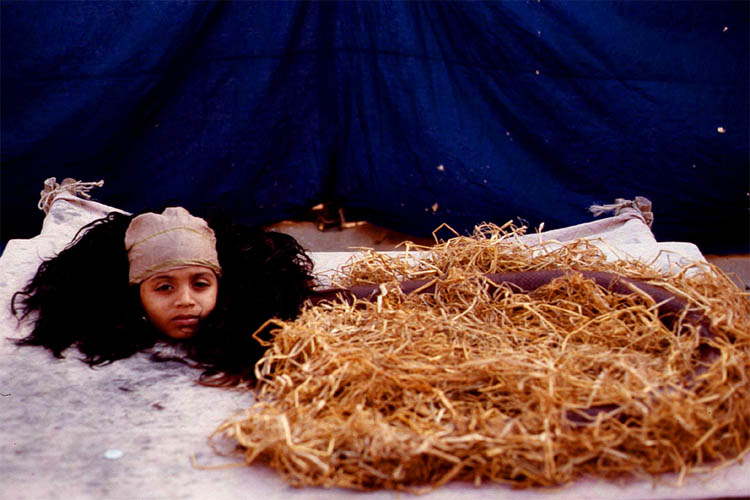
| A snake with a girls head?
|
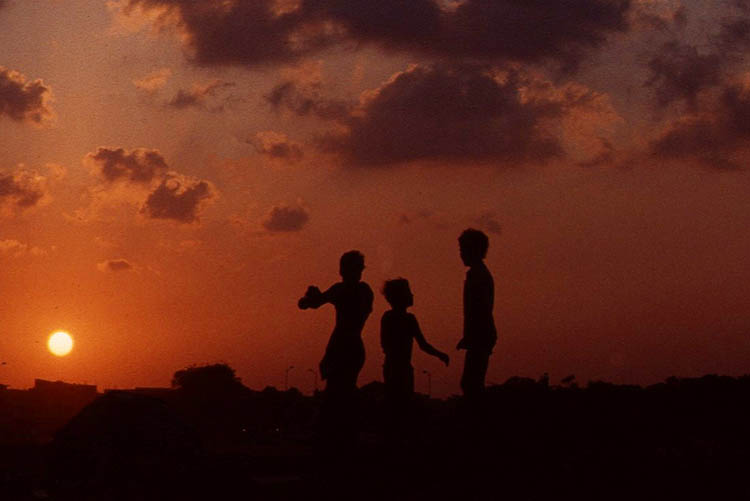
| Kids playing during sun set
|
Beside the beach I actually was neither much up to the city life nor night life but rather going to the countryside. So next morning I hopped on a bus going to my next destination.
Pondicherry
This town was even much better than expected. It also changed its name to Puducherry in the meantime. As a former French colony it has a French flair magnifique mixed with Indian mystique: French buildings and Indian ashrams (like the famous Sri Aurobindo Ashram), and restaurants with a French-Indian mixed cuisine (delicious French onion soup). It also was a nice place to stroll along the waterfront and through the town by foot.

| The Ghandi memorial is a famous sight
|
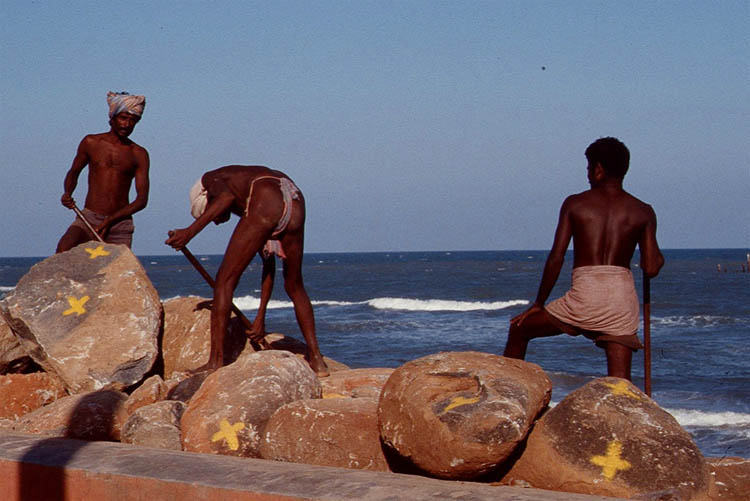
| Workers are enforcing the quay to protect him right
|
Also the surrounding countryside was very interesting but better to be explored by bicycle. You can rent one in most hotels in Pondicherry. First destination was the community of Auroville, which first was an idea of "The Mother", wife of Sri Aurobindo, who founded the Ashram in his name. There are around 80 settlements with almost 1500 residents, mostly foreigners from more than 30 countries. There I met a Danish guy living there for many years with his family. The following pictures show the Matrimandir, the spiritual and physical center of Auroville. Maybe we will have a Euroville in Europe, someday, where all not otherwise integrated nationalities will be living together in one community as an experiment.
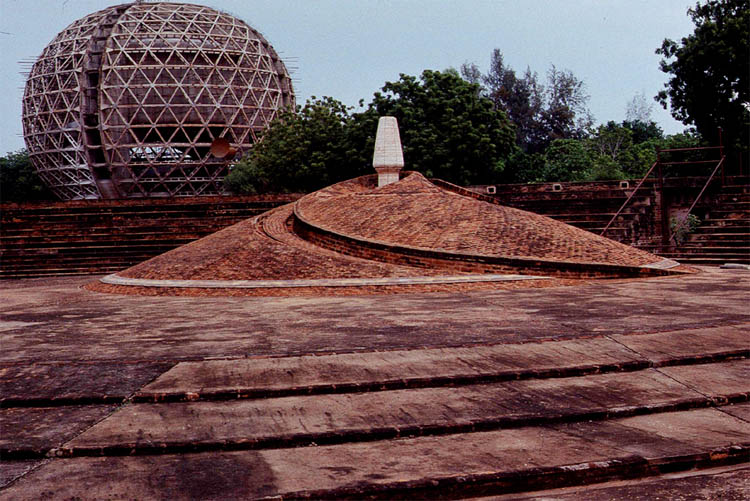
| In Auroville many nationalities are living peacefully together
|
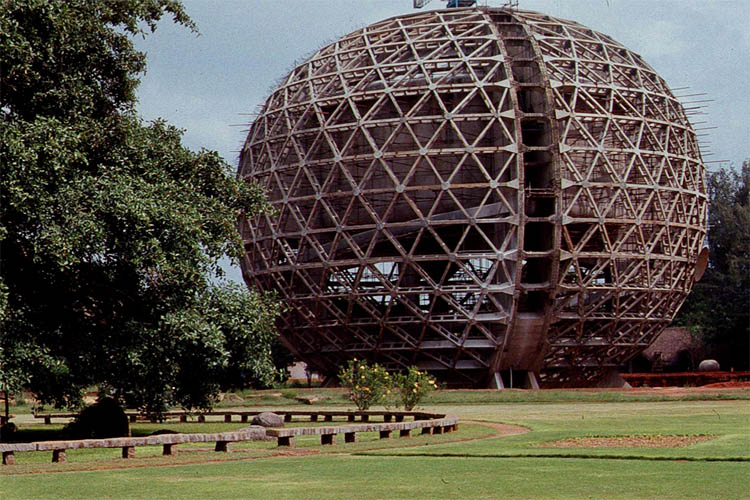
| It's another way of life with a new philosophy, but is it really better?
|
People with all kinds of faith are living here together peacefully above all creeds and politics. Or at least it seems. Indians are not always tolerant to people with other religions as some of their rampages between Hindus and Moslems, and sometimes Christians can tell. It is hard for Westerners to understand the Indian psyche. So, I didn't understand what the many clay horses were built for.
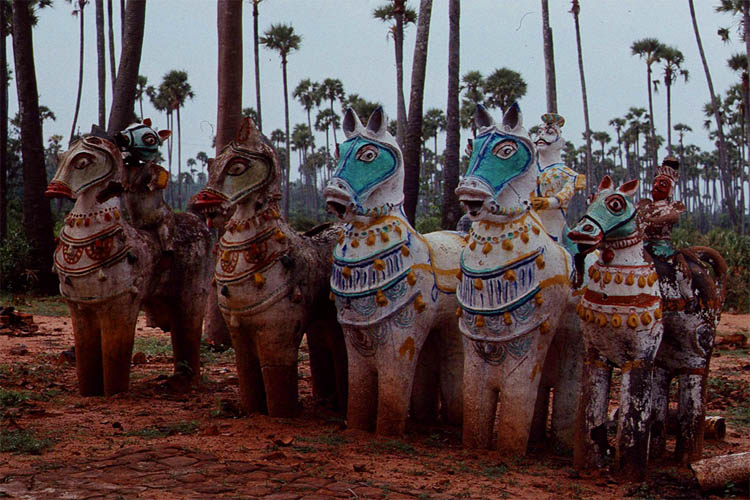
| Are the builders of these clay horses nuts?
|
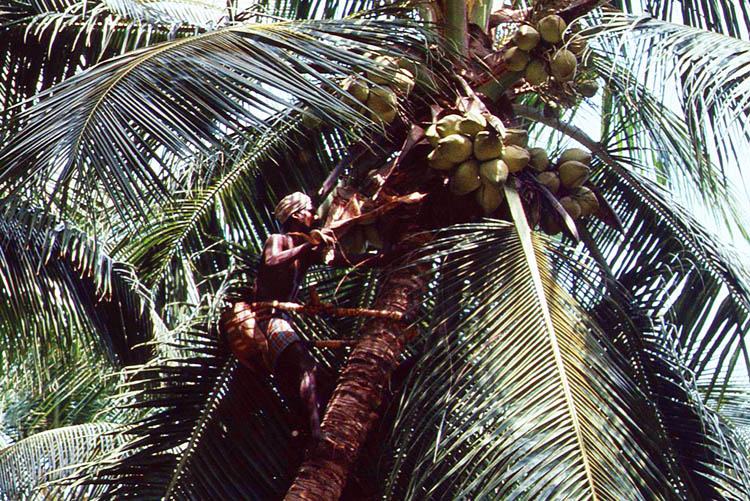
| Real life is hard enough harvesting coconuts
|
Bicycling from village to village and watching the daily life of the people was very interesting. The locals were very friendly and I was never asked for a baksheesh, not even by the kids.
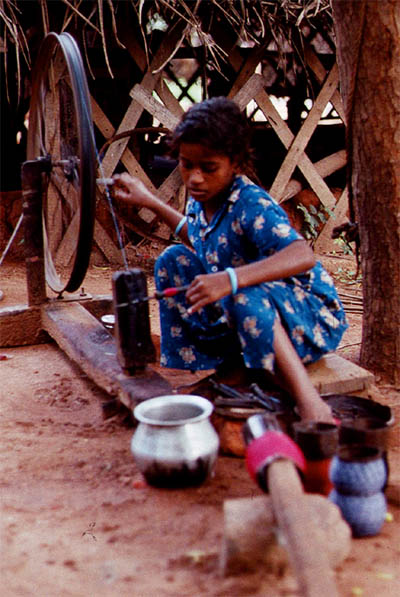
| Girls working all day as a wheeler
|
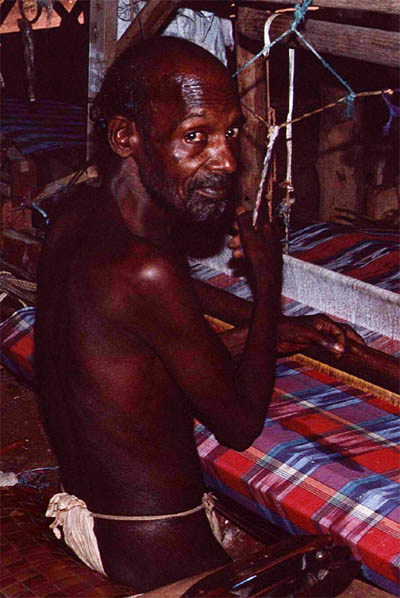
| Is as hard as working as a weaver
|
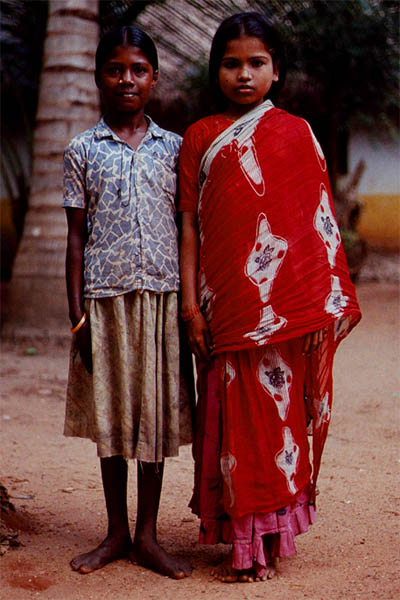
| These girls seem to be happy and not worried
|
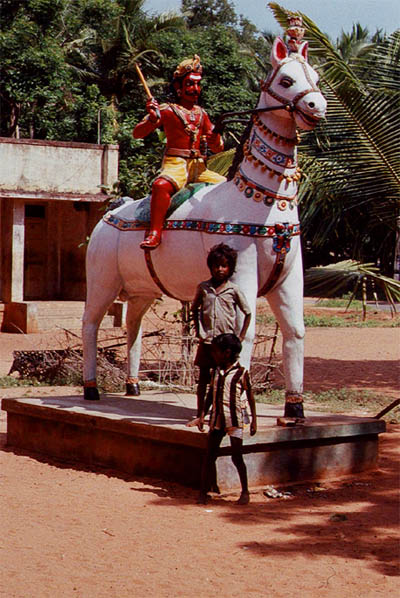
| and these boys have to watch out for the clay warrior
|
Then back to my hotel, or better to my pilgrim hostel. It had strict rules like a youth hostel: no whiskey, no cigarettes, no ladies, no music. After a good night's sleep in heaven I headed to the bus station next morning, where a boarded a bus just ready to leave for Thanjavur (never checked any bus time table before).
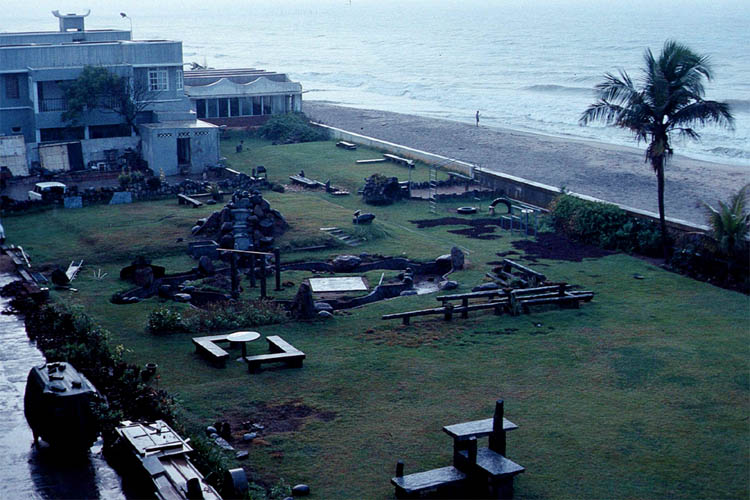
| Looking out of my pilgrim's home
|
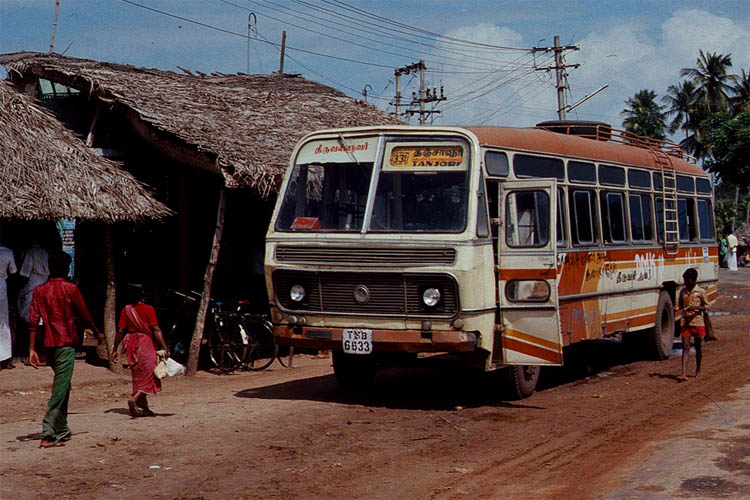
| Now I have to leave for the next town
|
Thanjavur
On the bus a met another German traveler and we decided to stick together for a while. Actually it is not always my intention to look for company. I also try to delve into another culture and intermingle with the locals as much as possible and having enough own time for contemplation. And this was actually the place for it: the fantastic Brihadishwara temple area and the beautiful palace complex. All built by the Chola kings, who ruled from the 9th century to the 13th century. Krishna is the most worshipped deity here. I do not want to elaborate on Hinduism now. It would be too time consuming. Rather take a look at following pictures.
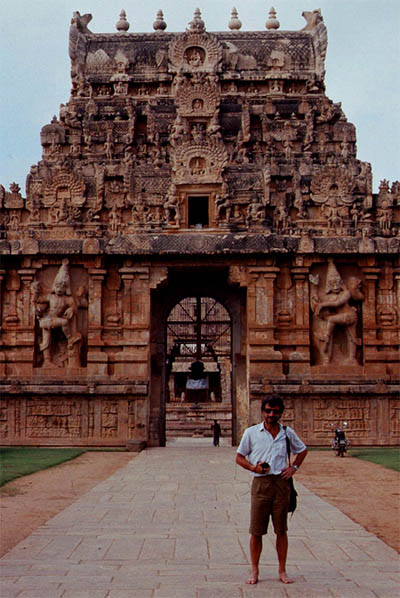
| A fellow traveler I met: a German
|
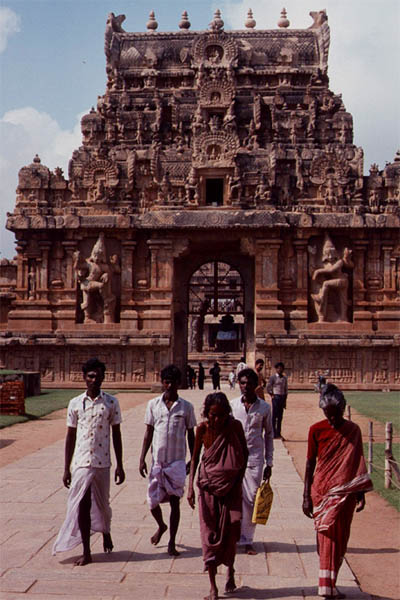
| before I will become another Indian
|
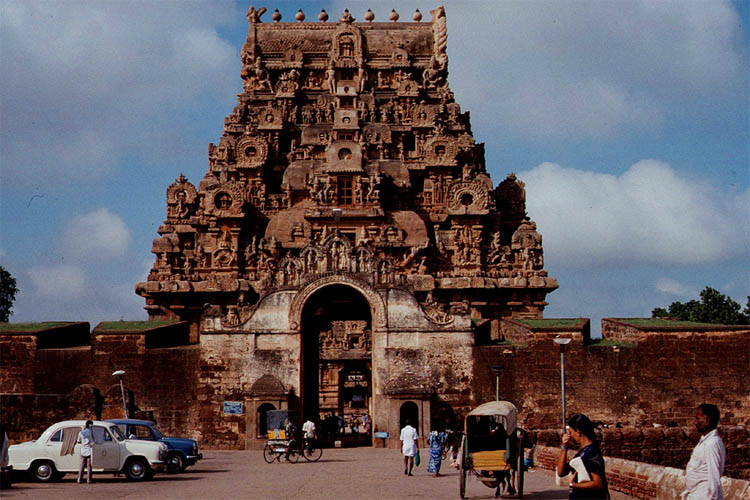
| This was my first real temple of India I saw
|
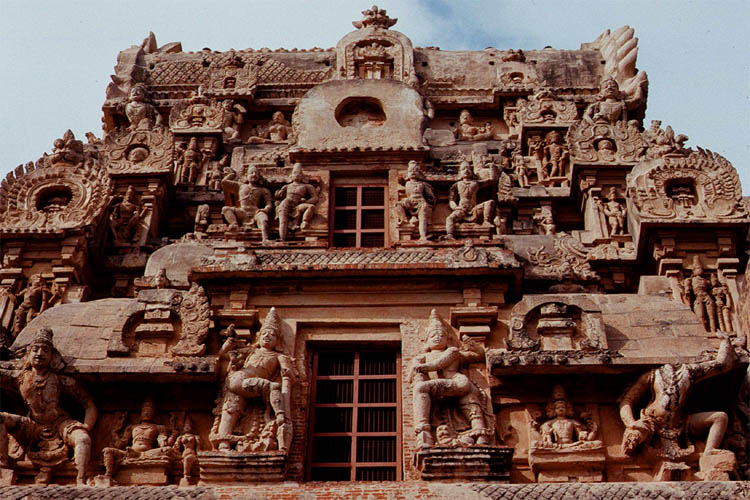
| They are so beautiful I had to look up in awe
|
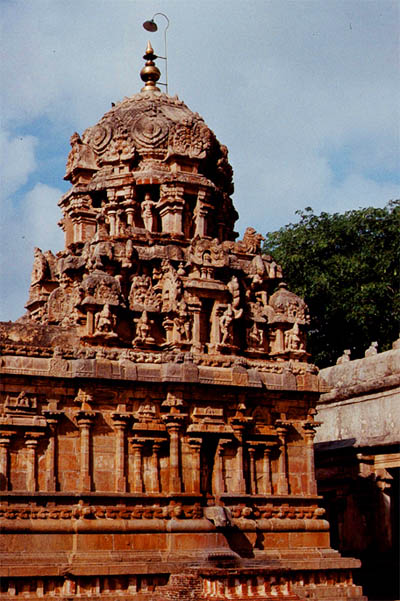
| There comes one temple after the next
|
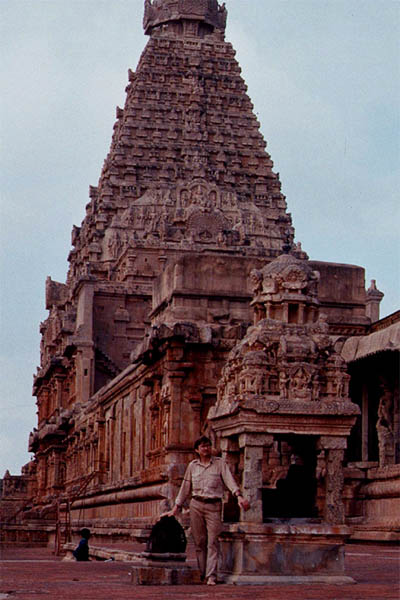
| It's a whole complex and I am perplexed
|

| Especially about the workmanship
|
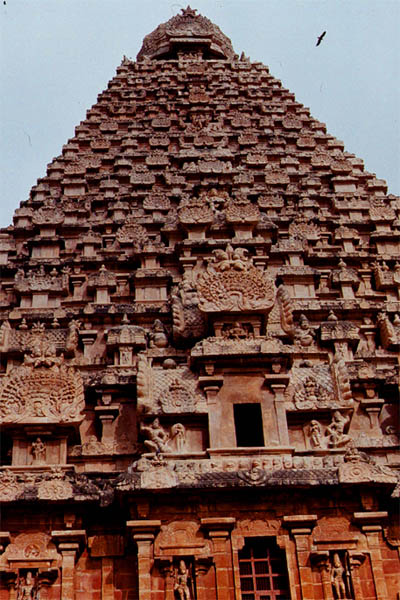
| How did they climb up to the top of this?
|
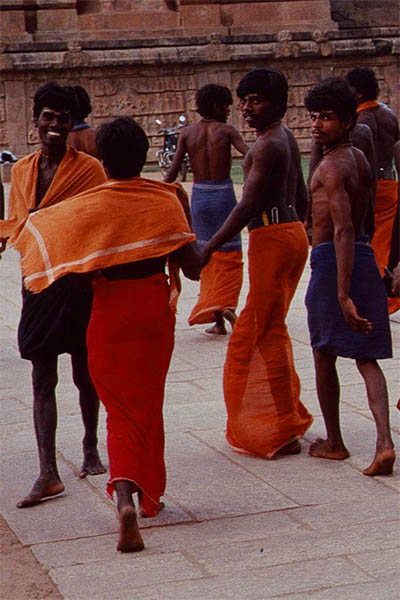
| Many young Indians come here
|
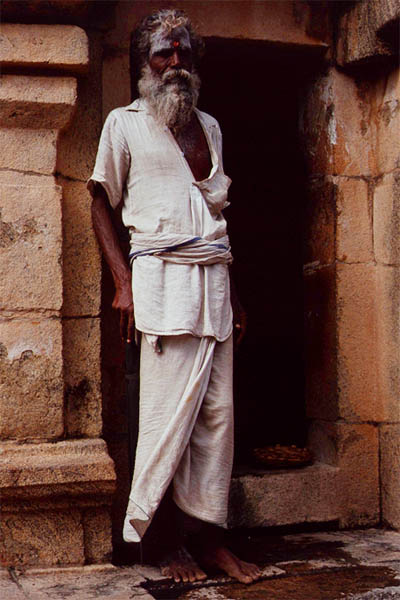
| This holy man may live here
|
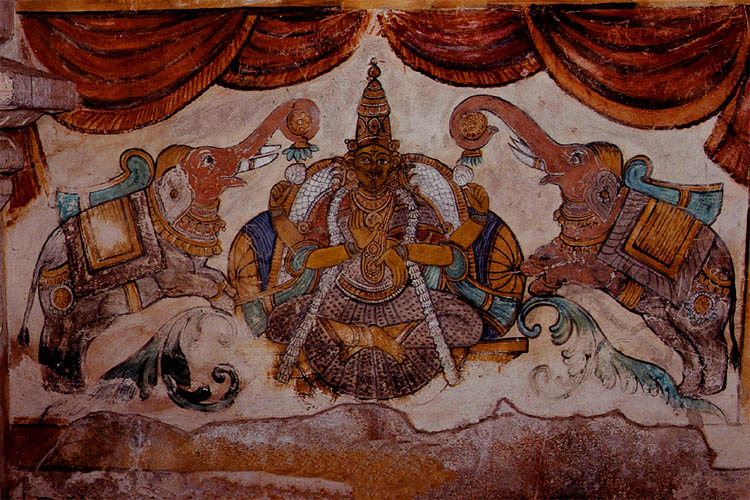
| Elephants and a guy with four arms painted on an old wall
|

| This elephant does not want food but coins, even if small
|
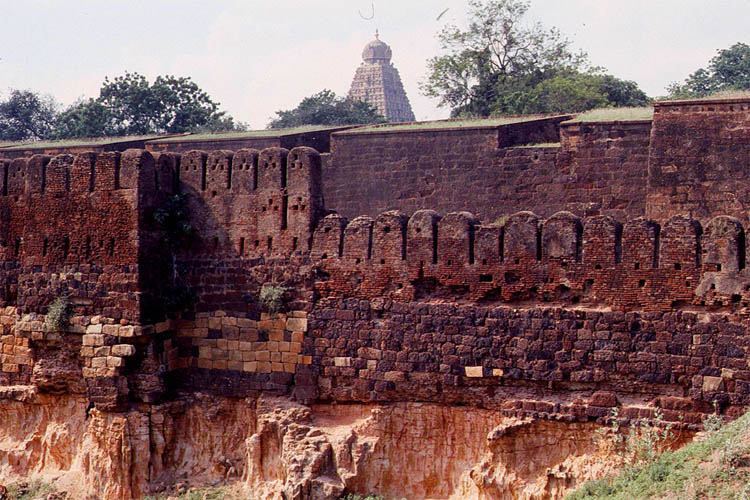
| Old walls of the old city still stand
|
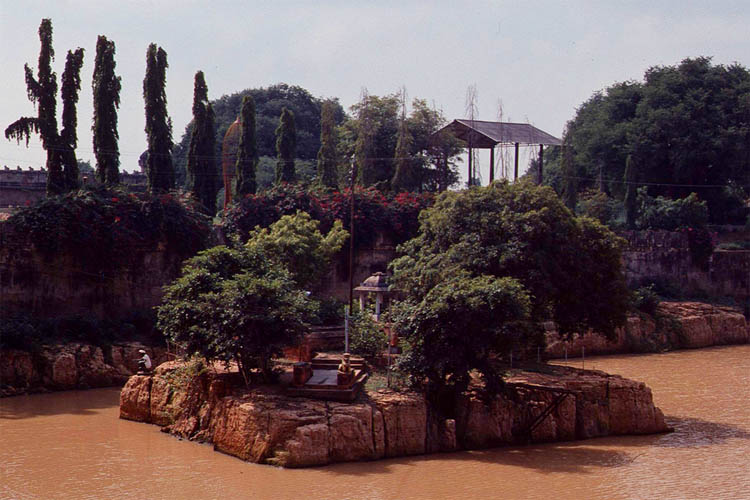
| An island in the middle of a tank
|

| View from a museum building
|
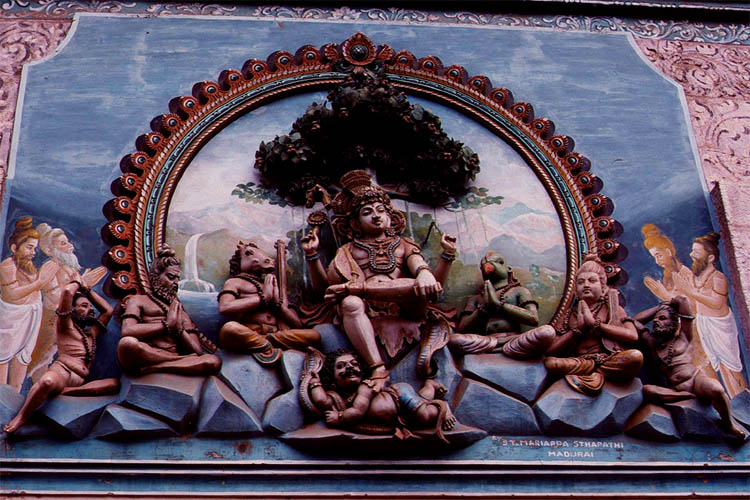
| And inside a modern painting
|
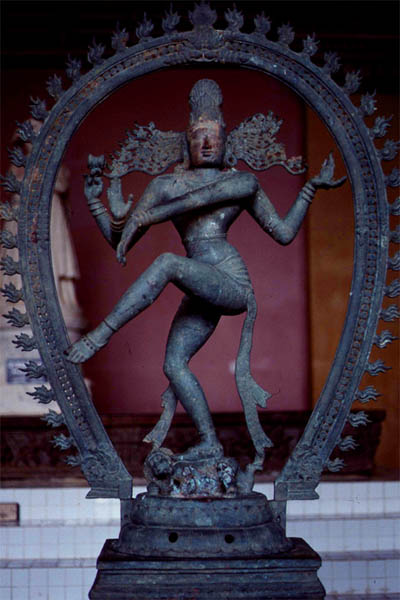
| This other four armed guy is a God
|
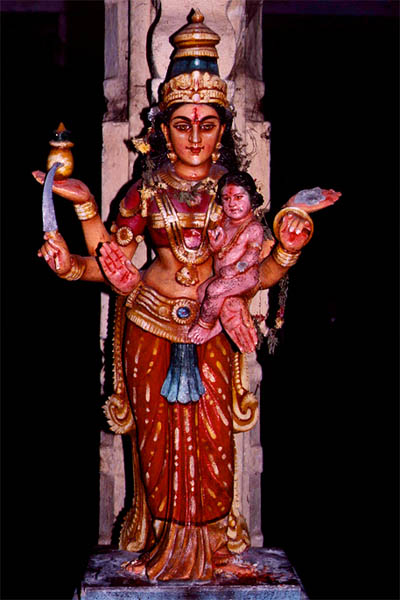
| Is this Maria with the son of God?
|

| This looks like a voluptuous temple dance
|

| Is the maharaja begging to get the next dance?
|
Tiruchchirappalli
Next stopover was at the city of Trichi, short for Tiruchchirappalli, a tongue twister. This city was even more fantastic and could flaunt with nicer and higher temples within the city boundaries and in the surrounding countryside. In addition, there were other interesting places like the huge tank in front of the Christian Lourdes Church to be admired from the top of a hill with a different temple and a fort.
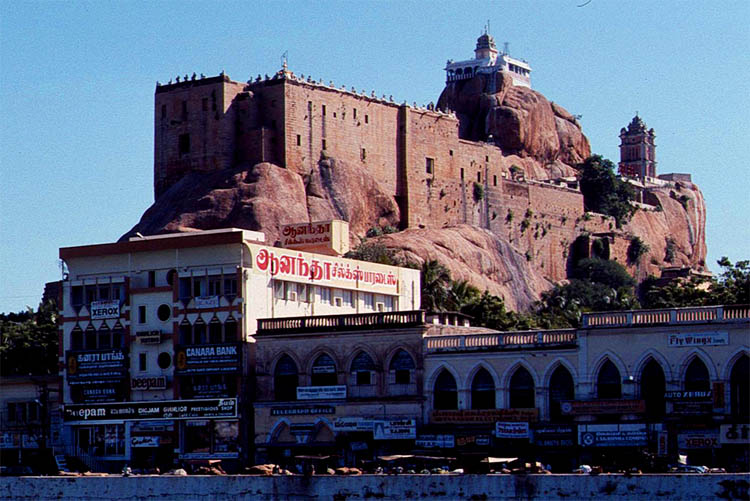
| View from the tank to the top
|
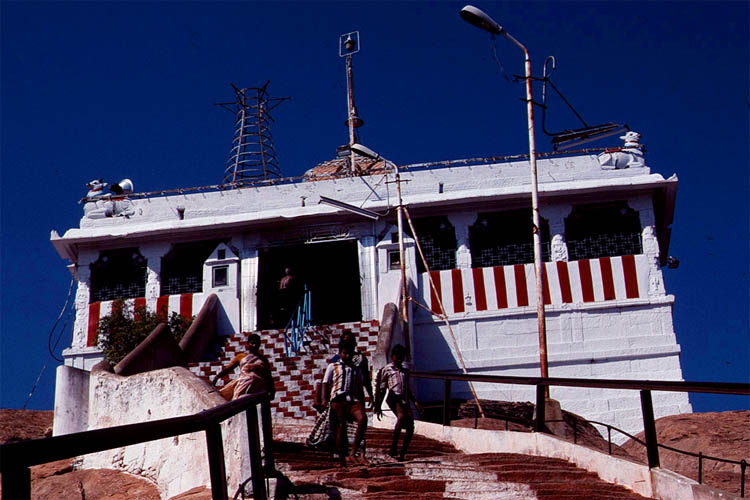
| Before the top a short stop
|
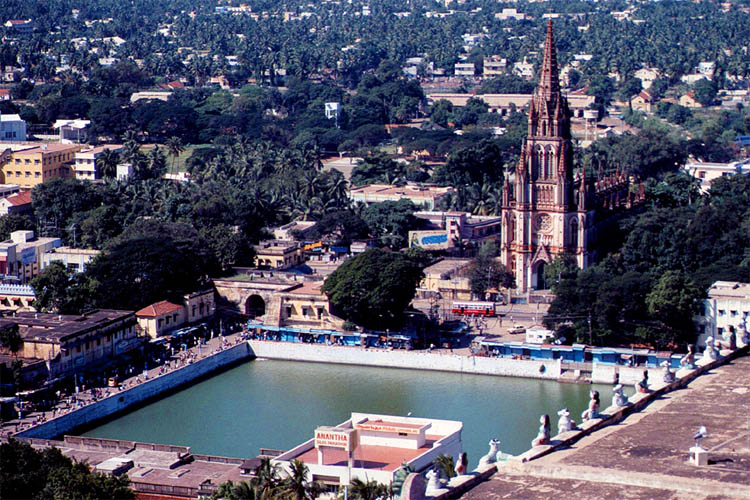
| View down to the city with the tank
|
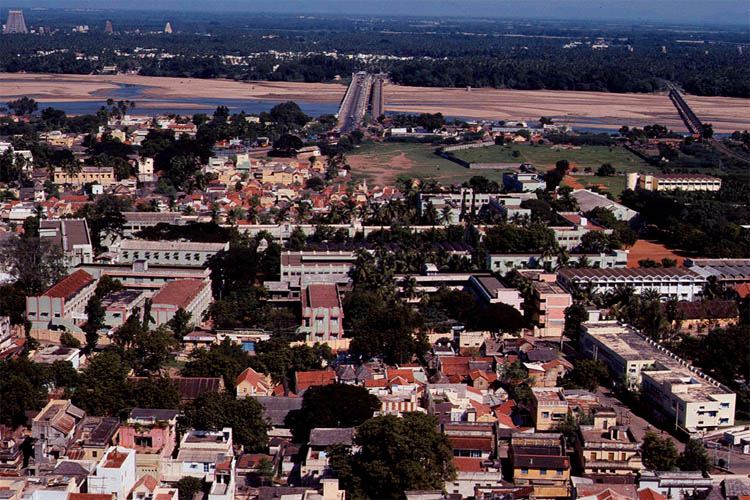
| View over the city to the river bank
|
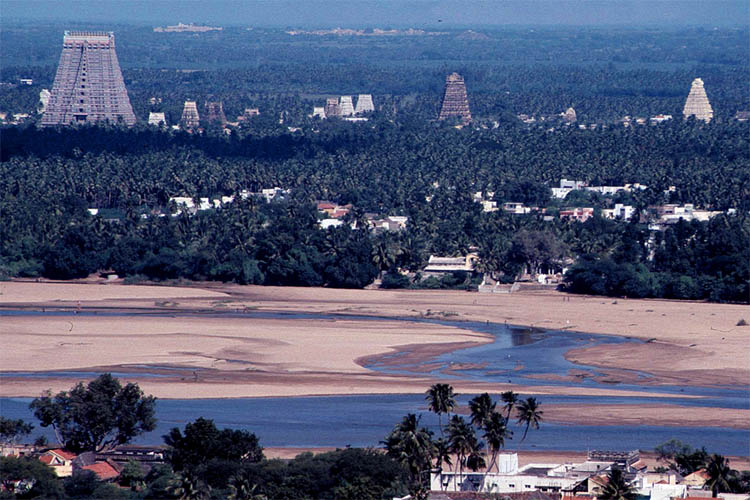
| Do you see all the temples in the back in the wood
|
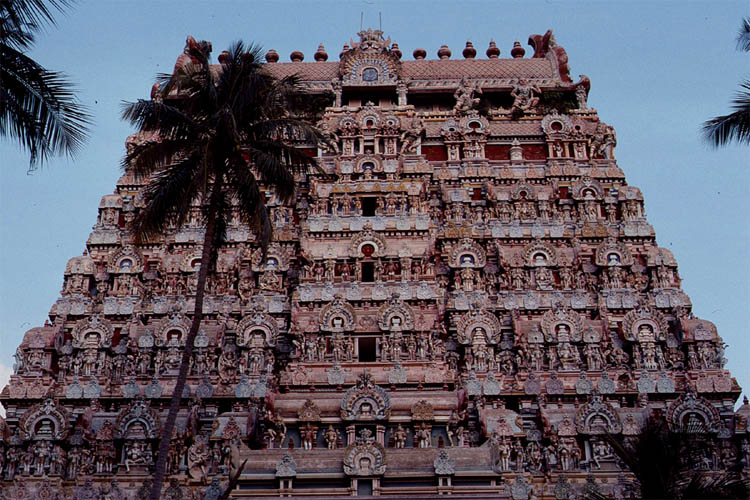
| Couldn't get there fast enough for a close-up look
|
The most impressive temple is the Sri Ranganathaswamy temple on the other side of the river. It is dedicated to Vishnu. Construction started around 1000 years ago and many dynasties helped to get it finished many hundred years after. The main entrance even was finally completed in 1987 with a height of 73 meters.

| This temple looks impressive behind the trees
|

| And this temple looks higher than the trees
|
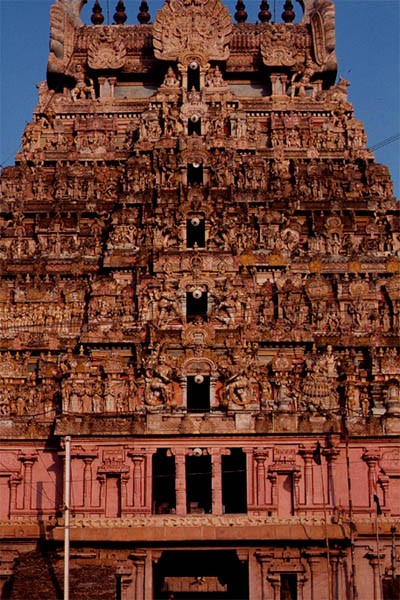
| Some are taller
|
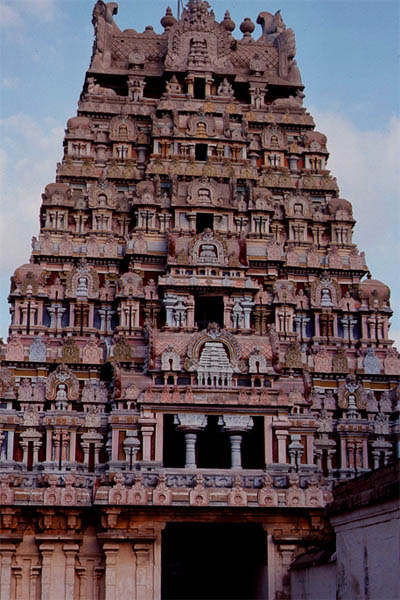
| some are smaller
|
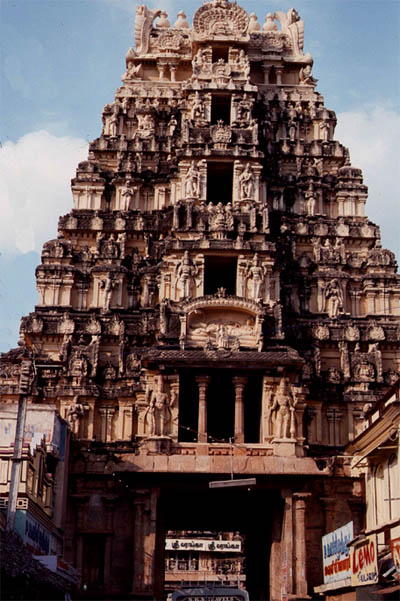
| But everyone has been differently designed
|
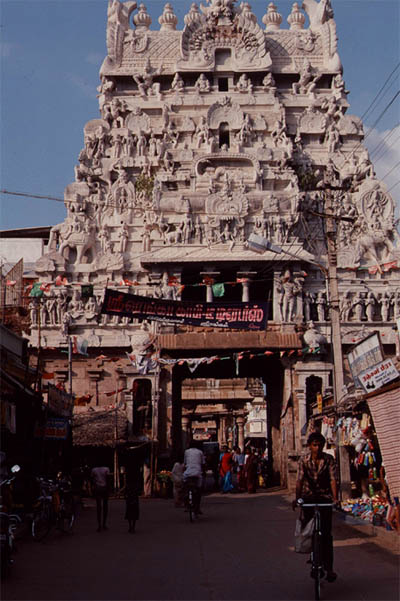
| And there is often another temple behind
|

| In front of the temples are waiting the beggars
|

| and all around is busy life with all the vendors
|

| Holy cows and behind is our guesthouse
|
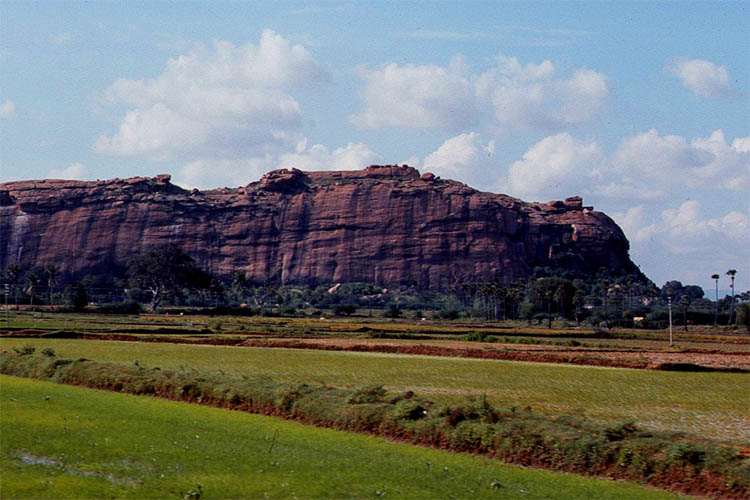
| A nice rock on the way farther down south
|
Madurai
After another bus ride about 150km down south we reached Madurai. This city is much bigger than Trichi and holier, because it is one of the most important pilgrimage centers in southern India. So there were more bustling crowds and many holy cows, polluting the air with methane more than the few carbon monoxide producing vehicles. Main transport was still the good old bicycle.
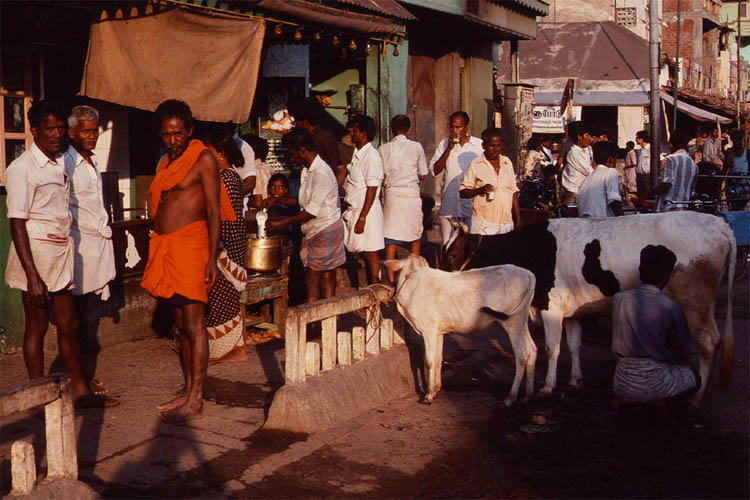
| Holy cows are also being milked.
|
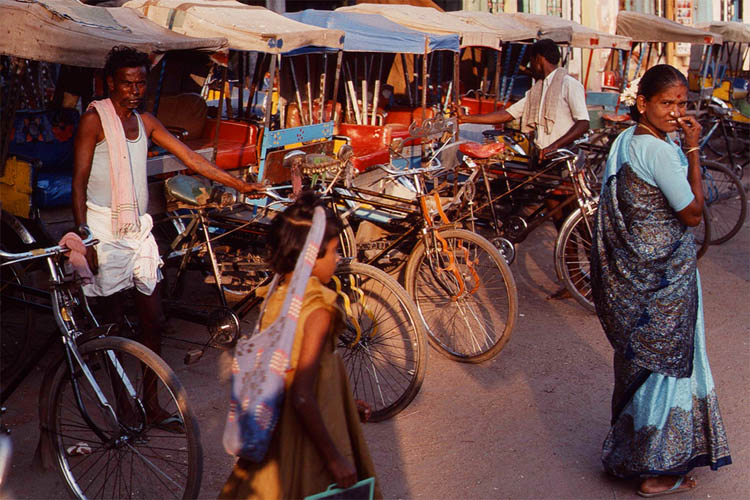
| Drinking that milk doesn't get you killed
|
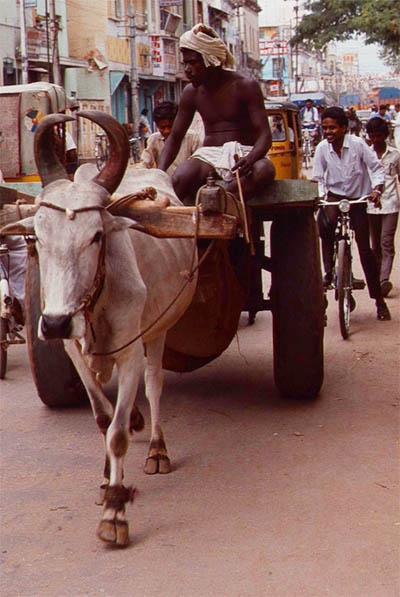
| A holy cow as a means of transportation
|
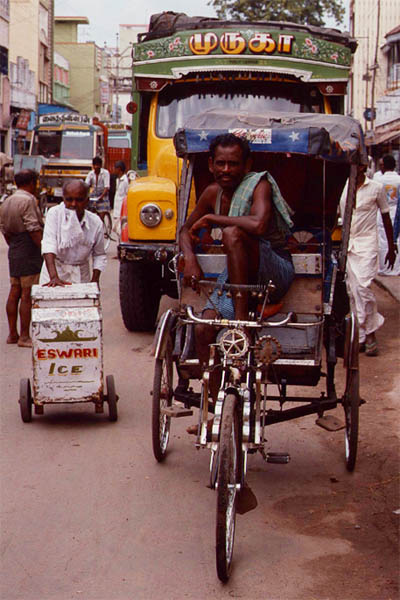
| But I would rather take a bike for exploration
|
Between 1300 and 1700, the rulers of Vijayanagar built 2,000 temples dedicated to various deities. The Meenakshi Temple in Madurai is an example of these impressive temple complexes. They were self-contained villages with kitchens, stables, and other buildings surrounding the shrines at their center. The dominant features of the temple complex are its twelve tower-gates, or gopuras, with a height between 45 and 50 meters.
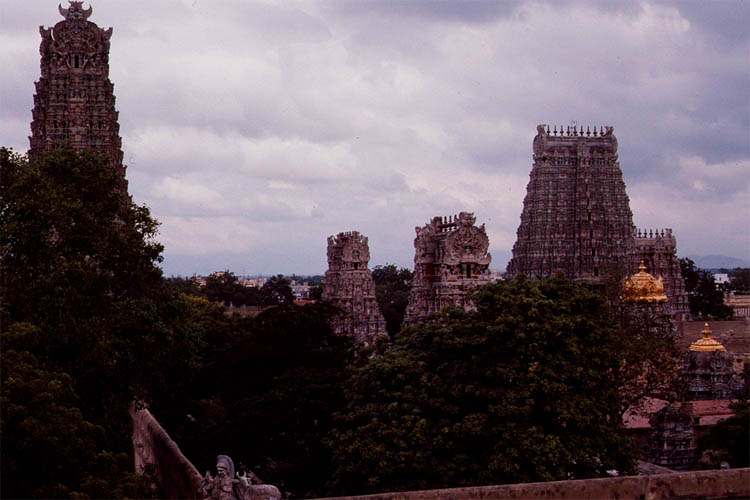
| Yes, this is a nice place to stay
|
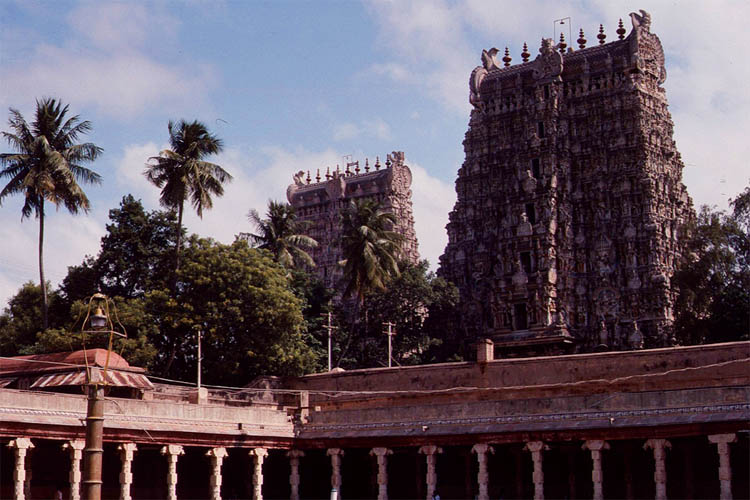
| In the temple city of Madurai
|
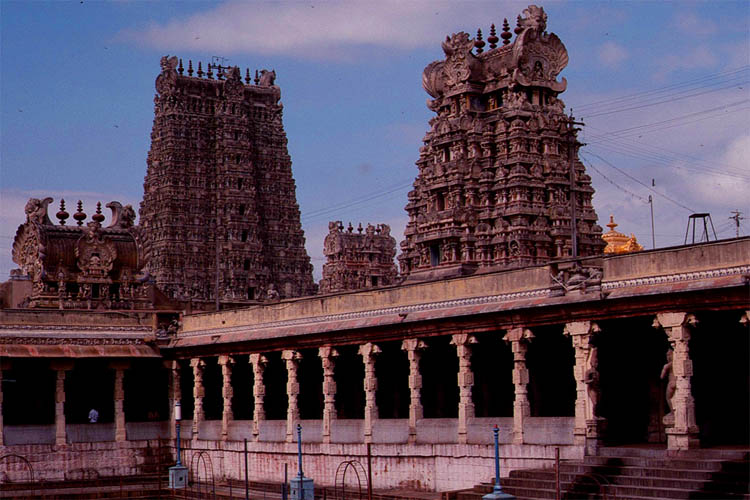
| There are good art examples
|
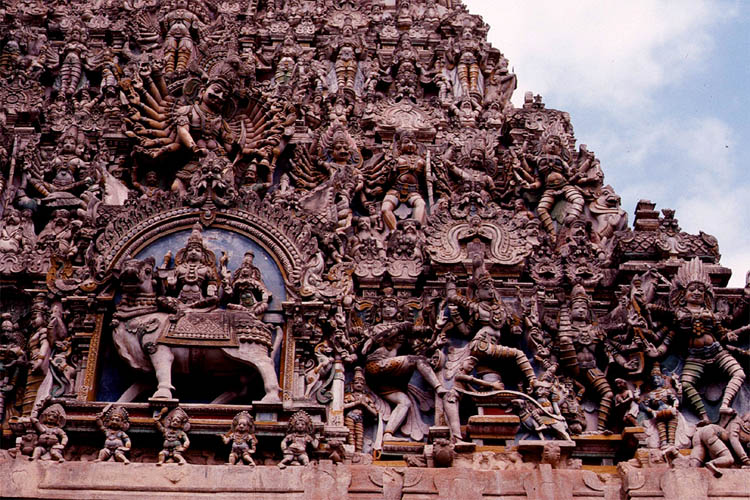
| The sculptures on the temples
|
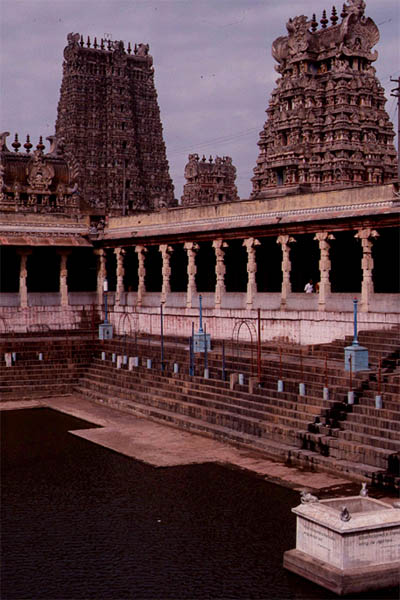
| Inside the temple area is a huge tank
|

| Also an elephant with a long trunk
|
The temple area was impressive. More so the folks roaming around, doing their holy chores, celebrating the religious part of their weddings, having traditional gatherings and last not least falling into prayer and contemplation.
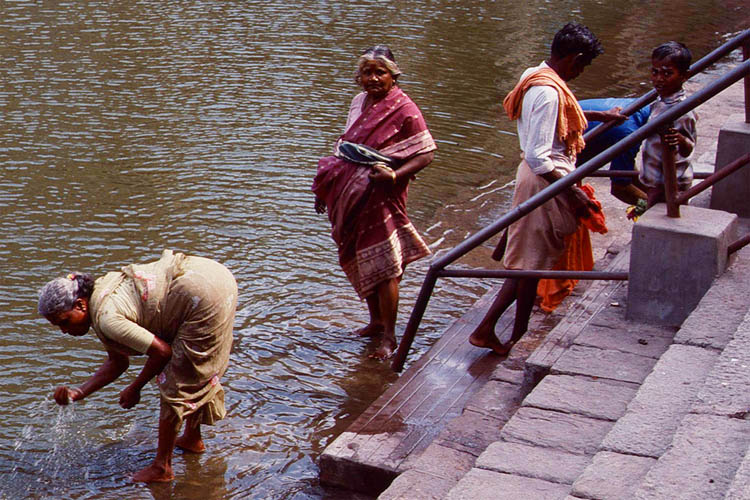
| The water of the tank seems to be holy
|
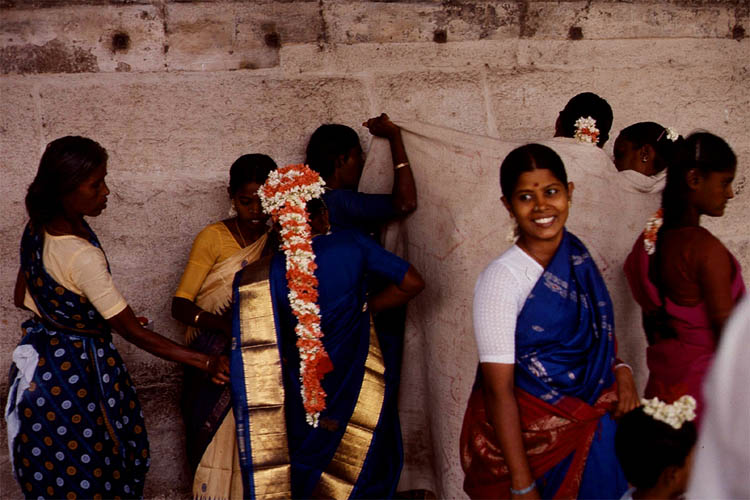
| Getting ready for a wedding ceremony?
|

| The beautiful bride looks very nice to me
|

| But she looks sad. Is it about the dowry?
|
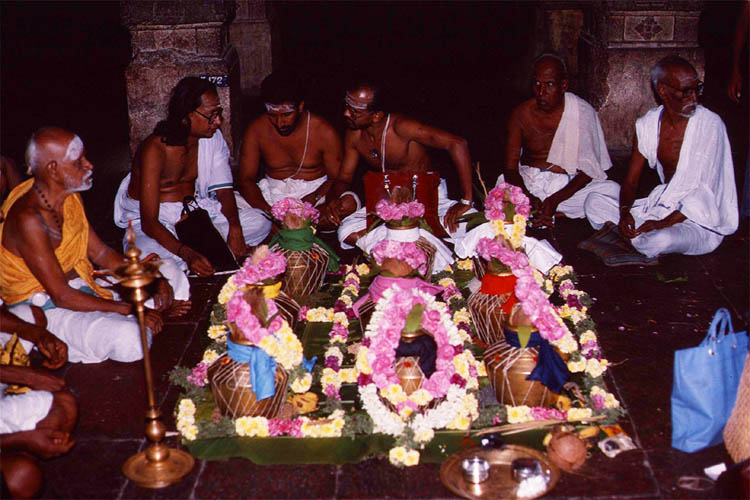
| These men have to discuss serious matter
|
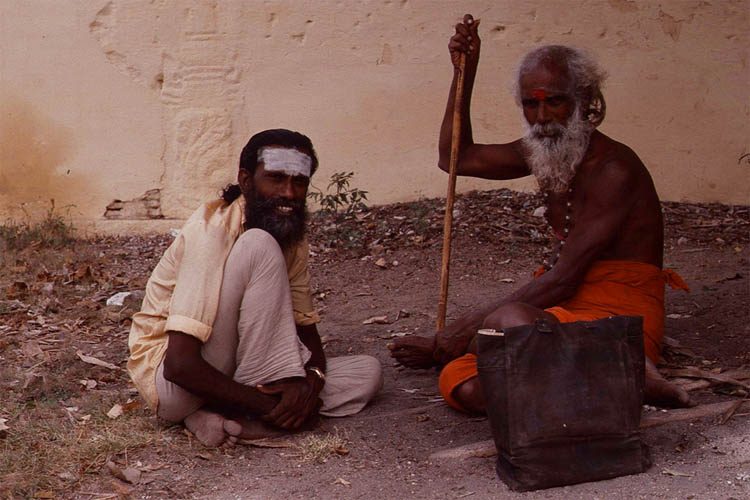
| These two guys don't care and seem to be happier
|
Outside the temples people are doing their own chores and going after their own businesses for a living.
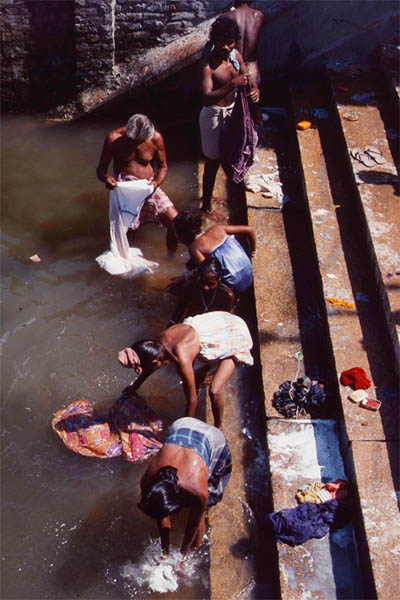
| Doing the laundry
|
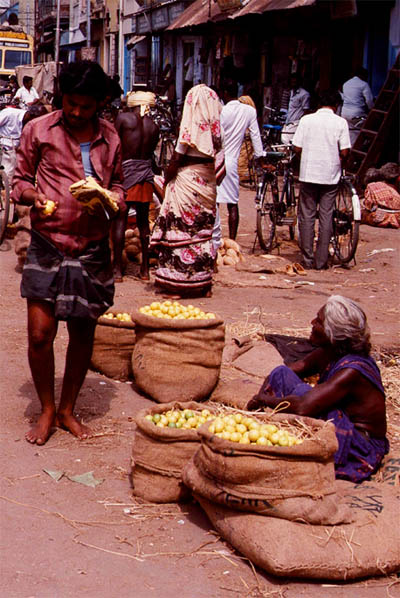
| Checking the quality
|
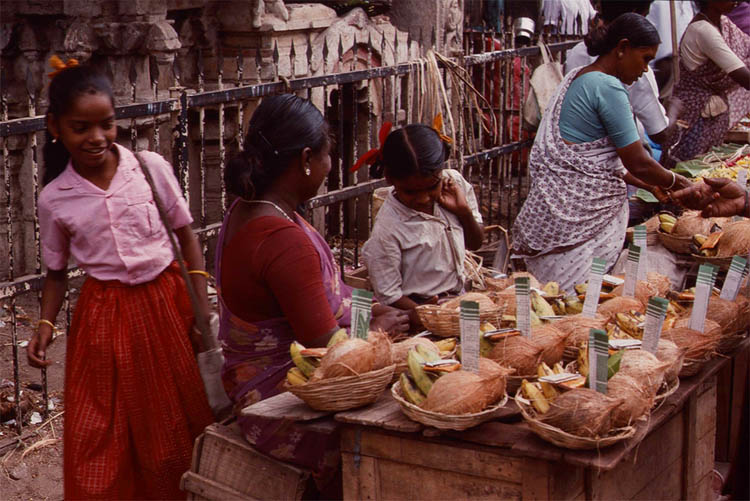
| This is used as an offering
|
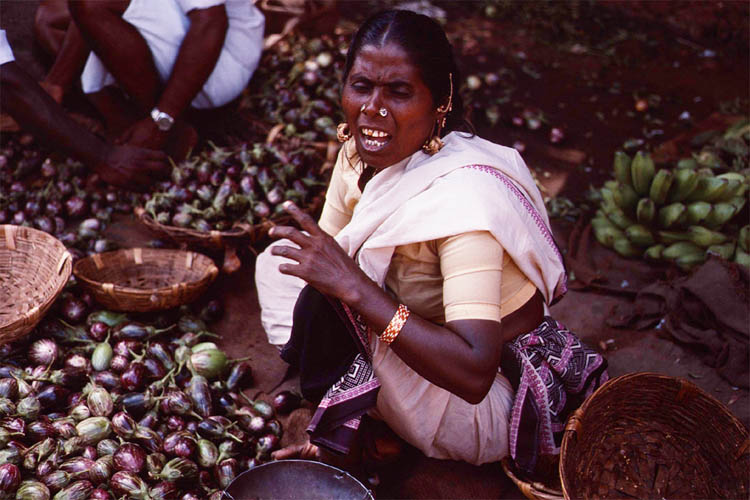
| And what is she offering?
|
It was an interesting day which was concluded by a late night sound-and-light show in the Tirumalai Nayak Palace.
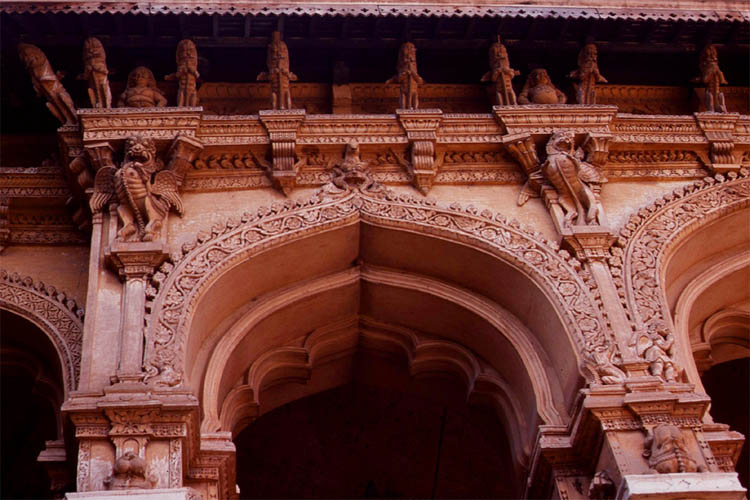
| What's next now
|
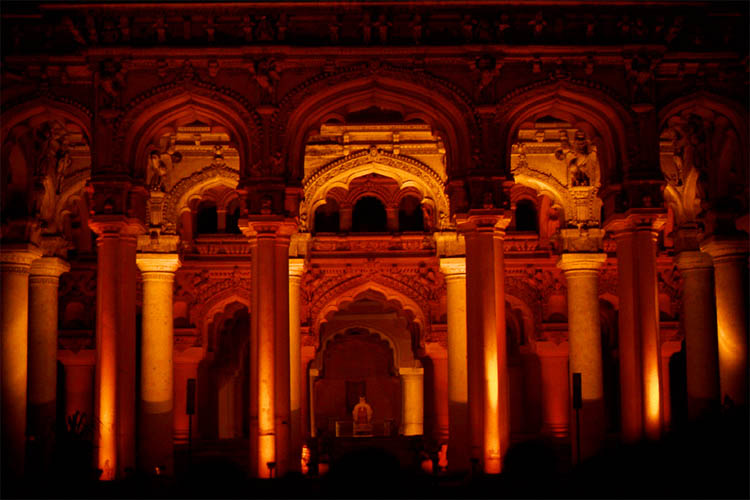
| A night light show
|
We had seen enough temples for now. What to do or go to next? My companion decided to go directly to the Kovolam beach for a swim, but I wanted to see one famous landmark first.
Kanniyakumara
This place is at the most southern tip of India. Here is also the Gandhi Memorial. It was an intermediate resting place for his ashes until dispersed in the sea. The small island, 400m offshore, however, is the Vivekananda Memorial, where one of the most famous religious leaders meditated.

| Finally I am reaching the most southern tip of India in the evening
|
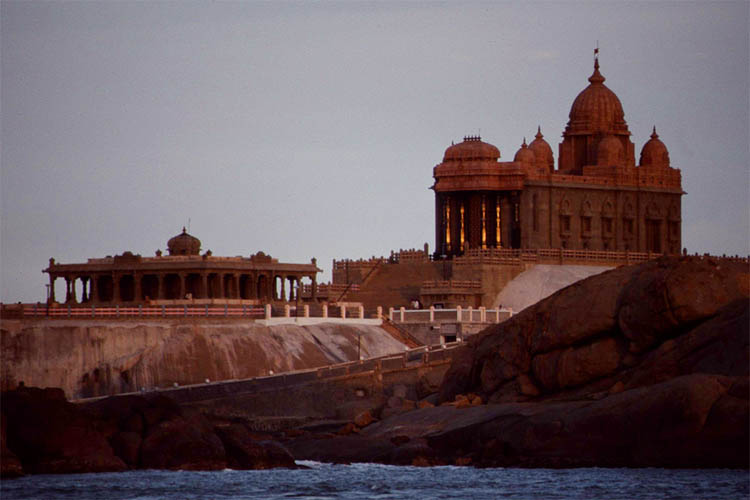
| This is the memorial place where a religious leader was meditating
|
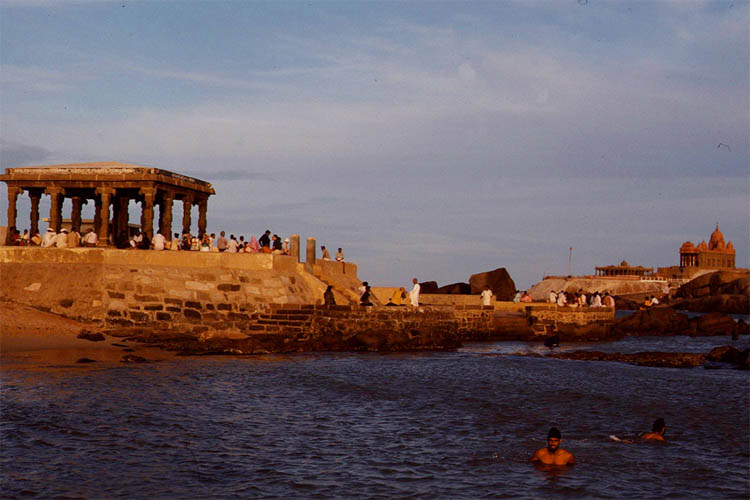
| Many pilgrims come to this place
|

| also relaxing from the rat race
|
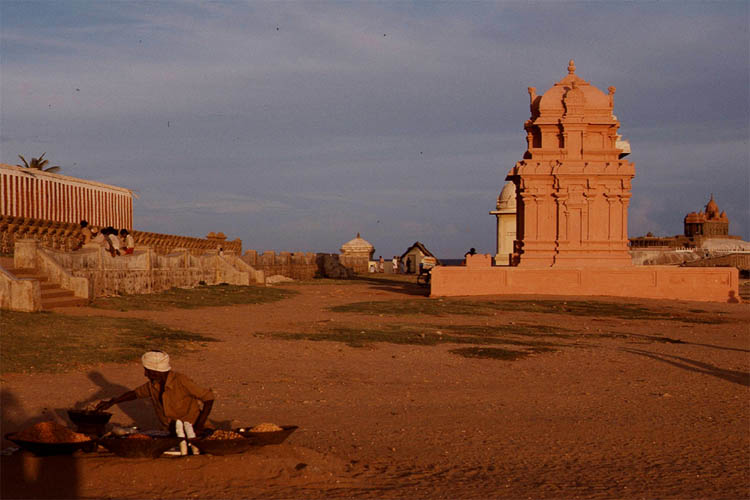
| Now it's time for a man the dinner to prepare
|

| Isn't it a nice peaceful evening atmosphere
|
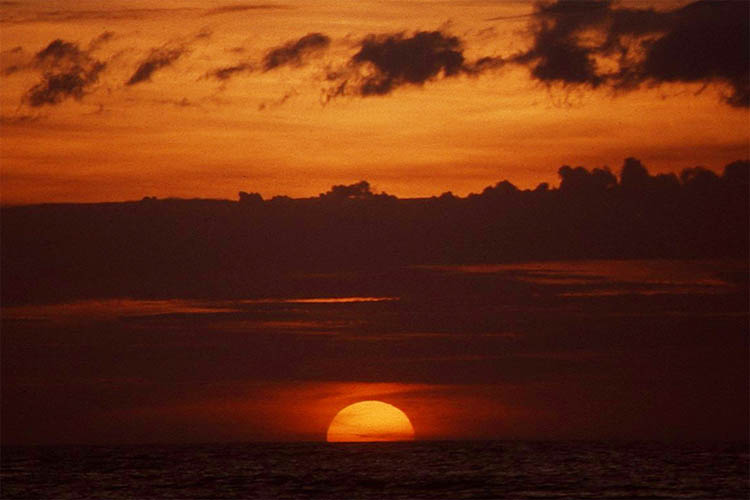
| The sun goes slowly down over Cape Comorin
|
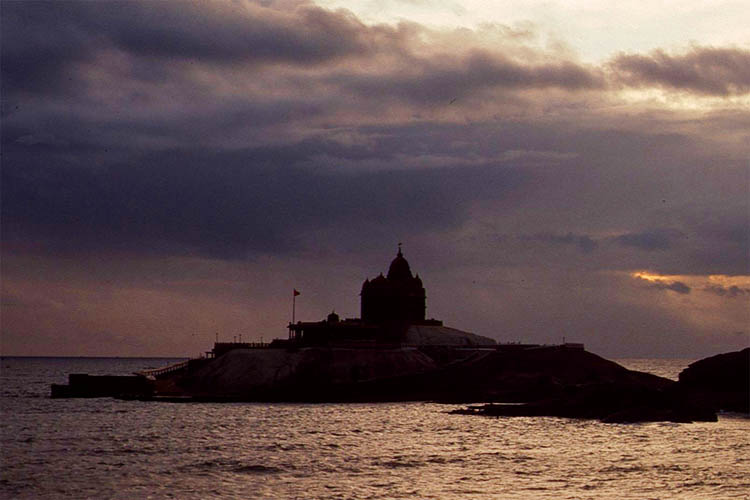
| Good bye, Gandhi, one of the best the world has seen
|
If you want to skip now to the other parts, then just hit
Part II - Kerala, Mysore, or
Part III - Goa, Bombay
| 































































































